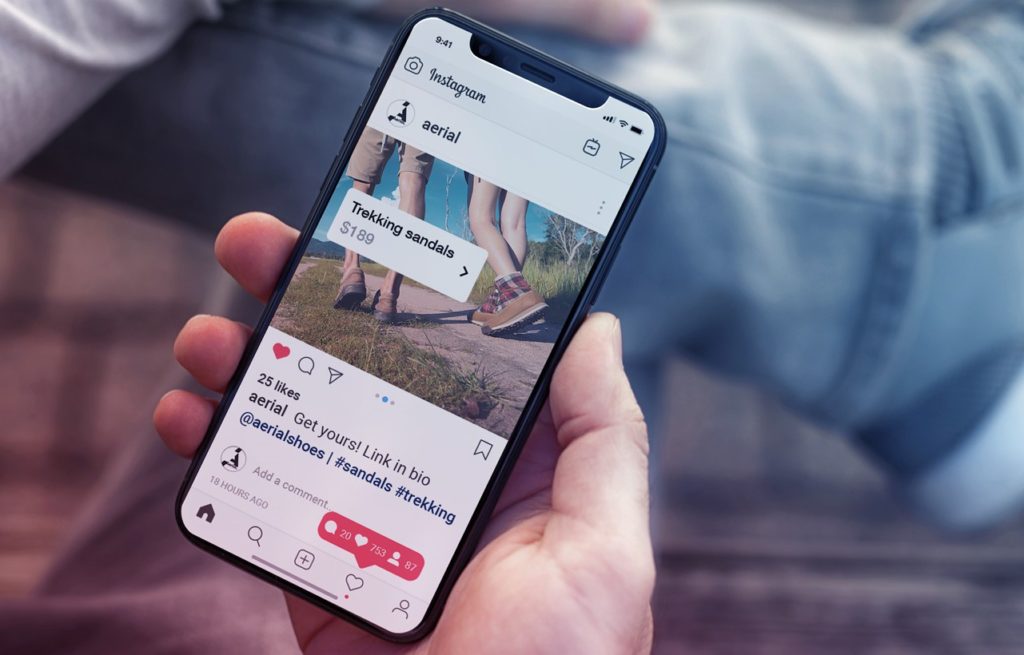How many hours a day do you spend on your phone? For most of us, the answer is more than we’d like. What those long hours of collective screentime mean for digital marketers is that businesses, across all sizes and industries, could really benefit from a great mobile marketing strategy.
Marketing campaigns that are designed specifically for mobile devices offer unique advantages. They’re cost-effective, easy to execute, and can fit seamlessly into your existing marketing efforts.
In this article, we’ll take a deep dive into what mobile marketing means, which mobile strategies are currently most efficient, and what makes a mobile campaign successful.
What Is Mobile Marketing?
Mobile marketing is a digital marketing strategy that aims to reach audiences through their smartphones, tablets, or other mobile devices. The channels used to engage consumers include SMS, MMS, social media, email, mobile responsive websites, apps and push notifications.
In terms of reach, mobile marketing can do wonders. There are over 6.5 billion smartphone users worldwide, and by 2025 it is estimated that 72.6% (three quarters) of all internet users will be accessing the internet mainly via smartphone.

Advantages and Disadvantages
Let’s start with the bright side. Mobile marketing offers plenty of benefits.
1. Location and personalization
One of the biggest benefits of mobile marketing is the precise targeting it allows. People carry their phones with them all the time, wherever they go. You can gather a great deal of valuable information about your audience’s preferences and purchase history, that will help you reach the right segments, with the right offers, at the right time and in the right place.
2. Highly cost-effective
As we said, mobile marketing allows for precise, location-based targeting. This automatically reduces wasted ad spend, as your message reaches the right audience quickly. Moreover, mobile-only channels like push notifications, in-app ads, and SMS marketing are some of the cheapest channels available.
The bottom line is that mobile marketing is both efficient and cost-effective compared to other marketing techniques in terms of ROI.
3. Instant transactions
People tend to browse their phones when they’re bored or need to kill time. Much in the same way that items on the side of the checkout line at brick-and-mortar stores can catch your attention while you wait, mobile marketing can reach people when they need something of interest.
In a sense, this allows mobile marketers to capitalize on boredom and idleness and persuade people to make impulse purchases they weren’t necessarily planning on. Social media marketing is perhaps the most convenient channel for this purpose because it creates a seamless flow for the user.
4. Analytics
Mobile marketing provides a constant stream of data, which allows marketers to optimize their campaigns in real-time, collect important information for product improvements, and further focus targeting.
5. Potential for viral campaigns
When we run into something interesting, useful, moving, or funny online our first instinct is to share it with others. Mobile marketing makes everything easily sharable, which increases the odds of informal referrals between customers. It also creates the potential for your content to go viral and spread brand awareness at scale and at zero cost to you.
While all the aforementioned advantages are highly valuable, there are also a few disadvantages to take into consideration when planning your mobile marketing campaigns.
1. Little room for errors
Mobile marketing is by nature an immediate, real-time form of communication. While this immediacy has its benefits, it also leaves little to no room for errors. If you make a mistake in your messaging there is no time to fix it before the recipients see it, and sending out an error followed by a correction is hardly the first impression you want to make.
2. User costs
It’s true that unlimited data is becoming more accessible, but it doesn’t mean that everyone has an unlimited plan. Some people viewing your ads may be subject to standard data and texting charges. This is something to keep in mind when you formulate your mobile marketing strategy and decide how you’re going to reach different segments of your target audience.
3. Privacy issues
The rules and regulations regarding privacy protection are constantly evolving, and as a digital marketer you must keep an eye out for these changes. Because mobile marketing relies heavily on location, it is bound to be affected by policies such as GDPR and Apple’s relatively recent move to restrict IDFA data to opt-in users only.
Build trust in your audience by staying transparent, clearly informing users of their opt-put choices, and ensuring you have their consent.
4. Potential for poor user experience
We have previously mentioned the importance of making sure your website and all of your landing pages are optimized for mobile. While optimization for mobile has become the standard, ensuring a seamless user experience on mobile is not always easy. Technical issues can cause the design to function poorly on mobile screens, leading to high bounce rates and missed leads.
5. Viral potential can backfire
The potential of your content to be widely shared and even go viral is great in the right context. In the wrong context, however, it can become a liability and even cause you damage. If a piece of content that reflects poorly on your brand goes viral, it can ruin your reputation, which is difficult and expensive to fix. Double-check your content is carefully thought through and will land as intended before it’s sent out to your customers’ and leads’ mobile phones.
Mobile Marketing Strategies and Examples
1. Paid social media ads
We might be stating the obvious here but social media is the most important marketing channel you have, and 76% of users access social media using a mobile device.
Social media ads are a simple way to target specific segments of your audience with highly relevant offers. They’re also effective for spreading awareness of your brand and gaining social media followers. Run some A/B tests to determine which platforms perform the best for your brand.
2. Social commerce
One of the key social media trends for 2022 is making posts shoppable. Once a user comes across an item they like on Instagram, for example, they can buy it directly within the app. The idea is to minimize the effort for shoppers and give them instant access to their shopping carts. The retailer meets leads and customers where they are while browsing.
Does this actually increase conversion rates? Certainly. According to a HootSuite survey, 44% of participants said they use Instagram to shop weekly through shopping tags or the shop tab. While a relatively new concept in eCommerce, shoppable posts have the potential to boost sales and are expected to become even more prevalent in the near future.

3. SMS/text message marketing
In many ways, blasting texts and SMS marketing are the bread and butter of direct-to-consumer communication. They’re highly cost-effective, and SMS has close to a 100% open rate!
Text messages are great for time-sensitive offers and creating a sense of urgency. Think limited-time coupons, discount codes, or links to exclusive offers. Of course, this is a permission-based channel, meaning you can’t use it unless a user has given you their phone number and consent.
Growing your SMS list is similar to growing your mailing list – offer your audience an incentive for their phone numbers, such as discounts and freebies, add an SMS sign-up option on your checkout page, add an SMS opt-in list on your existing marketing channels, etc.
4. Video content
The popularity of video and its importance in any digital marketing strategy is growing by the year. In 2020, 63% of all mobile traffic was video traffic. This number is expected to grow to 76% by 2025. The emergence and the phenomenal growth of TikTok have definitely been a game-changer when it comes to video-focused marketing.
Quite a few items have gone viral thanks to the app and the hashtag #TikTokMadeMeBuyIt has been viewed more than 7 billion times.
Other social media apps have adapted to keep up with the TikTok trend. Instagram is promoting Reels, YouTube created Shorts and the list goes on. The bottom line is that short-form video is here to stay so it’s crucial to utilize it in your mobile marketing strategy.
Best practices for video ads are – starting strong, keeping it short, and staying relevant to your target audience and the platform you’re posting on. In general, people expect their mobile content to be entertaining and easily digestible, which is why short-form videos work so well. It’s also especially useful for reviews and educational content on products and services.

5. Voice search optimization
Optimizing your marketing for voice search is becoming increasingly important. Not only is the use of voice searches on mobile phones on the rise, but as of 2022, it is projected that over 50% of homes use a voice smart speaker.
Why does this matter to marketers? According to Invoca, 43% of people who own voice-enabled devices use them to shop. Of those, 51% use voice search to research products and 22% make purchases directly through voice search.
People also use voice search for location-specific recommendations, like local restaurants, shops, and services. Considering these trends, brands who invest in voice search optimization are a step ahead in the mobile marketing game.
6. In-app support to improve customer experience
Customer experience is everything. The most incredible marketing strategy is not going to help you grow if you don’t provide excellent customer service, support, and an effortless experience doing business. A positive customer experience increases the chances of customers referring their friends and family to you and becoming brand advocates by sharing their experience online.
In-app messaging and support are crucial for making life easier for your customers. Imagine running into a problem at checkout, for example. Now you also have to switch to desktop or be transferred to an external, inconvenient interface to contact customer service. That’s a surefire way for a business to lose potential conversions.
In-app support through live chat on your business’s app is an immediate way to communicate with your customers and provide quick and easy solutions to their problems.
7. Push notifications
If your business has an app, it’s safe to assume users can opt-in to receive notifications about offers, suggestions, and reminders. Done right, push notifications can be a powerful mobile marketing strategy.
In-app messages, on the other hand, do not require opt-in from users. It can be leveraged for longer and more in-depth communication, much like you would use email marketing. App inboxes provide a wealth of data to help you further personalize offers and improve user experience.
8. Visual search
Another search technology that is becoming more popular and impacting mobile marketing trends is visual search. It’s a technology that allows you to take a photo and upload it to a search engine like Google or Pinterest. Then, this search engine will generate results that closely match your object.
It may sound niche but research found that 6 in 10 millennial and Gen Z consumers prefer visual search over other search methods. Moreover, more than 36% of online shoppers say they have used visual search, with more than half of them reporting that they find this method more useful than text information.
Best practices for visual search optimization include:
- Offering multiple images of a product
- Using high-resolution photos
- Optimize image titles and descriptions
- Adding alt text to images
Final Thoughts
Mobile marketing is a powerful component of a digital marketing strategy and should not be overlooked. It’s highly effective, inexpensive, and allows you to reach your target audience anywhere, at any time with highly relevant, contextual, and personalized marketing content.
Above we have covered some of the most effective mobile marketing strategies at the moment. The most important thing when it comes to mobile marketing is to keep up with trends and stay ahead of your competition. Things evolve quickly in this field, and you want to be a trendsetter, rather than just a follower.
Need help with implementing any of these strategies? Give us a shout. We’d be happy to help you!



